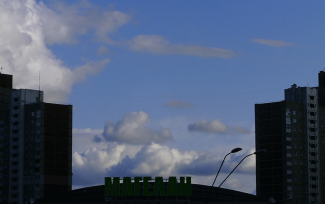Three days of calm in the Ukrainian skies. Day 1175 of the war


The unilateral ceasefire announced by Vladimir Putin on 8–10 May resulted only in a temporary decrease in the intensity of Russia’s activities. According to some Ukrainian sources, however, on some sections of the front, Russian activity remained at its previous level. Ukrainian forces tried to seize the initiative in the Toretsk area during this period, but attempts to push deeper into the city were unsuccessful. Subsequent Ukrainian attacks on the border of Kursk Oblast, mainly in the area of Tyotkino, also ended without result.
In the run-up to and just after the ceasefire, the Russians made further advances south of Kostiantynivka, pressing on a wide front between the road to that town from Pokrovsk and Toretsk. They also succeeded in driving the defenders from further positions between Pokrovsk and Velyka Novosilka, where they came within 1–2 km of the border of Dnipropetrovsk Oblast, and north of Toretsk. The Russian actions taken in other directions, however, did not bring any significant changes.

Between 8-10 May, Ukraine enjoyed a period longer than 24 hours without hostile airstrikes for the first time since February 2022. The Russian air force, however, continued its attacks in the area of the front, where, according to the Ukrainian General Staff, it also used one missile on 8 May. According to Ukrainian data, from the evening of 6 May until the morning of 13 May, the Russians are thought to have used a total of 444 strike drones and their imitators and seven missiles, with 226 downed and 151 drones locationally lost. Ukraine also reported shooting down two missiles.
Immediately prior to the ceasefire, Zaporizhzhia and Kyiv were the targets of massive strikes. A drone attack on the former on 6 May resulted in seven injured civilians and, according to some sources, the Ivchenko-Progress aviation plant was hit. A day later, missiles and drones hit Kyiv, where two people were killed and seven injured. Damage and fires occurred in four areas of the capital, and a communiqué from the local military administration indicates that four enemy drones may have directly hit the city for the first time (according to earlier communiqués, Kyiv’s air defence effectiveness against enemy drones was 100%, and that the damage was the result of falling debris). More serious attacks also affected Sumy (6 and 11 May), Poltava Oblast (twice on 7 May) and Bilhorod-Dnistrovskyi (12 May).

On 7 May, Ukraine carried out its largest air strike on Russian territory to date. Russian sources say that at least 524 strike drones were used (in the previous record-breaking strike, in March this year this number was around 350). Five Neptune cruise missiles, HIMARS launcher rockets and JDAM guided bombs are also thought to have been used. According to the Security Service of Ukraine, there were hits on the premises of two leading enterprises of the Russian arms industry – Bazalt in Krasnoarmeysk in Moscow Oblast and Splav in Tula. Explosions in the area of the industrial facilities in Tula and in Saransk in Mordovia were reported by local Russian sources.

The US has agreed to transfer 125 surface-to-surface missiles for HIMARS launchers and 100 surface-to-air missiles for Patriot systems from German arsenals to Kyiv. This was reported by The New York Times on 10 May. This is standard procedure for US-made armaments.
On 7 May, Germany updated the list of equipment delivered to Ukraine. It included: three Slovakian Zuzana-2 howitzers (as part of a project co-financed by Denmark, Germany and Norway), 66 vehicles with reinforced mine protection MRAP, 27,000 155 mm calibre and 1,000 122 mm calibre artillery shells, 40,000 35 mm cartridges for Gepard self-propelled anti-aircraft guns, 150 armed HF-1 drones and 70 Vector reconnaissance drones, an unspecified number of missiles for IRIS-T air defence systems, ammunition for Leopard 2 tanks and RGW 90 anti-tank grenade launchers.
The newly appointed government of Friedrich Merz intends to keep information about Germany’s supply of armaments and military equipment to Ukraine secret, Der Spiegel reported on 9 May. According to the newspaper’s interlocutors, this is to cause “strategic ambiguity”, to hide activities from the enemy and to limit the intra-German debate on military support for Kyiv.
The Netherlands and Romania have decided to establish a joint technical personnel training centre for Ukrainian F-16 fighter jets, the Dutch defence ministry announced on 8 May after talks between the two countries’ defence ministers. It will be located at Romania’s Fetești base, next to the European Training Centre for Ukrainian F-16 pilots (EFTC), which has been in operation there since November 2023.
On 9 May, the State Special Communications and Information Protection Service of Ukraine and the Ministry of Justice and Security of the Kingdom of the Netherlands signed a memorandum of understanding on the protection of critical infrastructure. The document was concluded as part of the implementation of the March 2024 Agreement on Security Cooperation between Ukraine and the Netherlands. Head of the service Oleksandr Potii stressed that the step will strengthen cooperation in spheres such as the cyber defence and cyber security of critical infrastructure.

On 6 May, a 205/205 exchange of prisoners of war took place, the terms of which were agreed with the mediation of the United Arab Emirates. Since the beginning of the full-scale invasion, 4,757 Ukrainian citizens have returned from captivity.
Also on 6 May, the Kyiv government established the Inter-Ministerial Group for Improving the Recruitment of Foreigners into the Ukrainian Defence Forces. This follows on from April this year, when it adopted a resolution allowing the recruitment of foreigners and stateless persons on a contractual basis. In addition, foreigners serving in the Ukrainian army can apply for a temporary residence or immigration permit without requiring a minimum of three years’ residence in the country. The moves by the authorities indicate that the army is suffering from a shortage of personnel and is interested in recruiting soldiers from among citizens of other countries.
On 7 May, Ukraine’s Deputy Minister of Justice Yevhen Pikalov stated that around 37,000 convicts could join the Ukrainian Armed Forces as part of the mobilisation. So far, more than 8.3 thousand prisoners, including 100 women, have joined the ranks of the army, and the processing of another thousand applications is ongoing. People convicted of terrorism, corruption, sexual offences or crimes against national security cannot sign contracts.
Also on 7 May, the Agency for Defence Procurement (AOZ) notified parliamentarians that Pavlohrad Chemical Plant, which had supplied the Ukrainian Armed Forces with faulty mortar ammunition, had received a new government order for 59 billion hryvnias (over $1.5 billion). Viktoria Siumar, an MP from the opposition European Solidarity party, who disclosed the AOZ information, stressed that the faulty ammunition posed a threat to Ukraine’s defence capabilities and has cost the lives of soldiers. She also stated that procurement decisions could be the result of unfair lobbying.
On 10 May, the law enforcement authorities uncovered another corruption scandal. Six senior officers of the logistics board of the National Guard of Ukraine were suspended from their duties after corruption charges were brought against them. The Interior Ministry ordered an internal investigation and provided full cooperation in the investigation by the National Anti-Corruption Bureau (NABU). It concerns the misappropriation or embezzlement of property through abuse of position, the laundering of money earned through illegal activity and the acceptance of bribes. The investigators alleged that the suspects had accepted more than 190 million hryvnias (approximately $4.5 million) in bribes for favouring one company in tenders for the supply of goods and services, including armoured vehicles.
On 7 May, the Ukrainian government granted the Interior Ministry 1.6 billion hryvnias (approximately $40 million) from the state reserve fund for the construction of training grounds and firing ranges. The aim of this step is to strengthen the state’s defence capabilities and expand the training base for future soldiers.
One day later, the Kharkiv education authorities reported that from 1 September this year, the subject ‘defence of Ukraine’ will be replaced by basic military training in schools. Pupils will participate in theoretical and practical classes, including medical preparation. The schools will be equipped with shooting ranges and obstacle courses, and the classes will be led by veterans, among others. They will be provided for two hours per week with the possibility of organising one full day per month dedicated solely to training.






